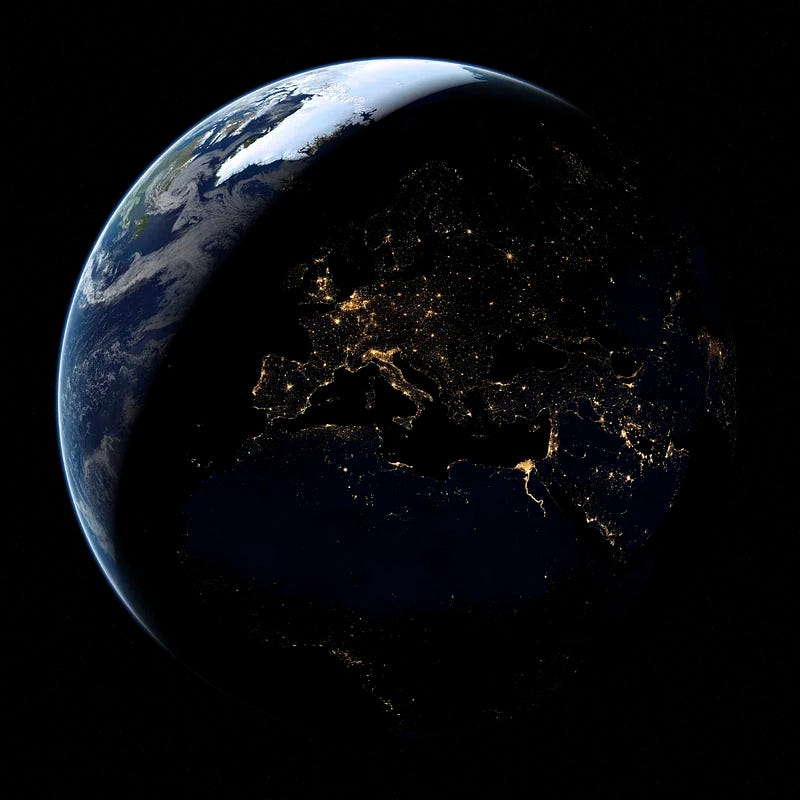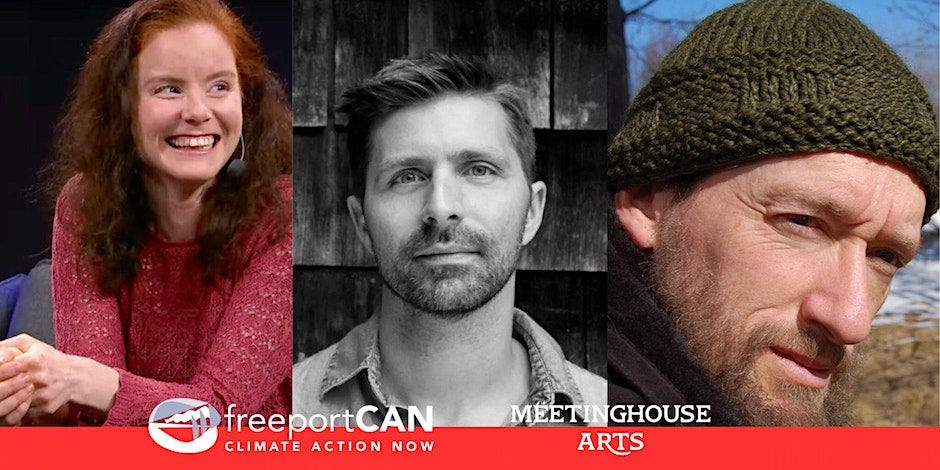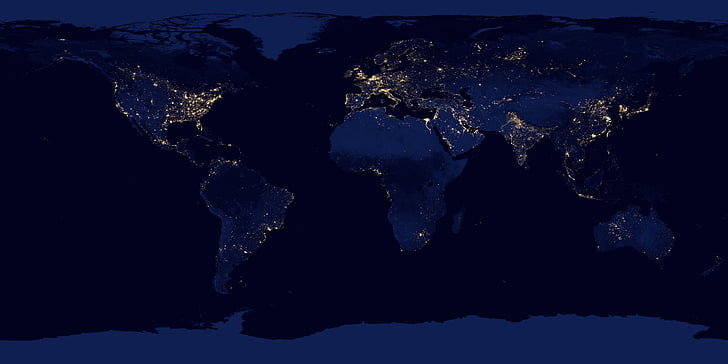Hello everyone:
Here’s a new feature of the Field Guide, the quote of the week. I’ll inaugurate the feature with something from
, in “The Rays of the Sun,” the latest issue of his Crucial Years newsletter:The global temperature readings for September should have been the top story on every newscast in the world, because they were bonkers. June, July, and August were historically hot – we saw the hottest days recorded on the planet in 125,000 years. September wasn’t quite as hot, of course, because it’s fall. But in relative terms September was even more outrageous. It was, the scientists tell us, the most anomalous month we’ve ever seen, with temperatures so far beyond historical norms that the charts don’t even seem to make sense… We have, in effect, turned September into July. That’s not hyperbole, that’s just data.
As always, please remember to scroll past the end of the essay to read some curated Anthropocene news.
Now on to this week’s writing:
I had the pleasure earlier this evening of sharing a stage with polar climate researcher and policy expert Susana Hancock and novelist Nick Fuller Googins in a panel discussion titled “Truths About the Health of the Planet.” The discussion was moderated by the wonderful
, who writes here on Substack. Kathleen and Susana are also two of the founders of Freeport CAN (Climate Action Now) of Freeport, Maine, where the event was held.Susana brought an incredible range of experience to the discussion, from her time on the Greenland ice cap to her work with the IPCC to her haunting anecdote of asking a “sustainability director” for a major oil company how, with two kids at home, he slept at night. He told Susana that 1) he worked late so that he wouldn’t have to face his kids when he got home, and 2) he hoped that his family might die in a car crash before they had to end up living in the kind of climate-addled world his corporation was making.
Nick and his book The Great Transition, meanwhile, offered a really beautiful yet pragmatic vision of a world where people and politics actually coalesced around solutions amidst the coming crises. He talked about the idea of utopia in a way we rarely hear today: not as a la-la fantasy of perfection, but as a hard-earned, practical arrival of programs, policies, or institutions that benefit society without any profit-driven trappings. Nick mentioned the Civilian Conservation Corps back in the 1930s and the public library system as past examples. We are a society raised on stories of dystopia, Nick noted, and he’s motivated to open our eyes to greater possibilities.
I was fascinated by the discussion of “tipping points” by both Susana and Nick. Hers are the dark planetary thresholds we’re likely to trip over as we warm the planet (Arctic methane, the slowdown of ocean currents, etc.) while his are the social movements that build slowly until suddenly shifting culture in good, large, permanent ways. We are, in this moment, caught in a vortex between both sets of tipping points.
Our event was part of a larger Truth Tellers Month in Freeport built around the exhibition of the remarkable series of 265 portrait paintings by Robert Shetterly titled Americans Who Tell the Truth. Also, the event was recorded to be broadcast at some point, though I don’t know details. If anyone is interested in seeing it, let me know in the comments, and I’ll pass along the info.
I was asked by Kathleen to share, in a ten-minute presentation, some of the truths that I’ve been devoted to telling here in the Field Guide. This was both easy and daunting, because in a transformed world the truths are large and small, innumerable and overlapping. What I came up with is by definition a very, very partial list, one focused on how we should understand this critical moment in both human and Earth history. In this list I have one eye on the world as it is – life on this planet disrupted by extreme human pressure – and one eye on what happens next.
My litany of truths starts in the darkness and works toward the shadowed light that is the answers we already have but are not yet really implementing.
This is a slightly longer version of what I offered on the stage this evening, since I decided at the last minute to shorten the reading. Also, I’ve included links and illustrations here in places where I think you’ll find them handy.
I’ll be curious to hear your comments.
***
We live in a critical moment in both human history and Earth history. Ordinary time has been distorted. The rapid acceleration of human activity has made mere decades relevant to millennia or even eons. What we accomplish this century will determine whether this industrialized version of human culture is a thoughtless asteroid or a thoughtful gardener.
The climate crisis, our excessive heating of the planet, is an existential threat to all life, including our own, but it's only one symptom of the larger set of changes we're making to the planet. This is an age of extinctions and ecosystem collapses; of the warming, deoxygenation, and acidification of the oceans; of the stripping bare of the land; and of the degradation of everything from the seafloor to the topsoil to the polar ice caps.
It helps to think of a disrupted climate as the last step in our planetary disruption process. We transformed the continents and oceans first, and the atmosphere was sure to follow. Still, it’s discouraging that a warmer, more turbulent climate reaches into every corner of the Earth that the bulldozer, plow, chain saw, and trawler could not.
Emissions must be radically reduced, but they’re not the only cause of the climate crisis. To warm a green planet, all you have to do is reduce the greenery. A planet which has lost at least a fifth of its wetlands, and whose land surface has been deforested, urbanized, paved, and tilled at a grotesque scale will be warmer. It’s a profound disruption of the water cycle, which is an important controller for the climate.
Fixing climate is crucial, but it isn't enough. Climate change is a threat multiplier for our other changes to land, freshwater, ocean, and biological systems, but if we suddenly eliminated our emissions, we'd still have all of the other sweeping impacts that have severely reduced plant and animal populations.
We’re not paying enough attention to the rapid loss of plant and animal communities. Those who are paying attention tend to call it the “biodiversity crisis,” but that’s like calling climate chaos a “temperature crisis.” How many of us know, for example, that humans and our livestock make up 96% of all mammal biomass on the planet? Every wild mammal on Earth, from whales to camels to mice, add up to just 4%.
Fossil fuels are at the root of much of what’s gone wrong. Our burning of millions of years of stored carbon in mere centuries has provided the energy for our growth, of course, but petroleum is also the alchemical substance from which we’ve derived nearly all of the toxic chemistry that plagues and infiltrates the natural world: plastics, fertilizers, pesticides and herbicides, PFAS, and countless other industrial chemicals.

Some profoundly important research has identified nine planetary boundaries - thresholds for a stable planet - and we are transgressing six of them. These include impacts to climate, freshwater, and the integrity of the living world. In our insistence on unlimited growth, we’re creating an entirely new balance, one that is increasingly unfriendly to the array of life that has nurtured our species.
We can never fully return to the world that our parents and grandparents were born into. The speed and depth of the Anthropocene transformation are simply too much. We are obligated to make the best version of a new, altered world. So much great work is being done to conserve/protect/nourish the natural world, but no matter what we accomplish in rewilding the Earth, the world will be profoundly different than the one of just a century ago. How different, and how disrupted, is up to us.
Human population is an important part of the Anthropocene story, but it's a hard conversation to have. The history of white guys talking about population is rife with racism, eugenics, and genocide. But there are simply too many of us using too many resources for too little reason, especially in wealthy nations. It took all of human history to reach 1 billion about 200 years ago. Now we add a billion every 12 years. Every person has the right to a good life, but so does every living community. I think that means we need a smaller population.
A cultural shift is necessary because a cultural shift is how we got here. 99% of human history has occurred without widespread disruption of planetary boundaries.
Science and technology will be as important to the solution as they were to creating the problem, but they’re not enough on their own. Tools are always a reflection of the toolmakers, so the toolmakers must change first.
We need a different ethics, a higher value system that will make us slow our harmful behaviors and accelerate some better ones. Pope Francis is doing a remarkable job at trying to motivate his flock, but we need a civilizational ethic of respect for the living world in which religious and secular thinking can intersect.
Indigenous land management and cultural values are essential to the path forward. Indigenous peoples make up about 5% of the human population, but protect 22% of Earth’s land and 80% of her biodiversity.
We all have little levers and big levers we can use to reshape culture and help the community of life. The big levers are mostly changes in policy, especially better regulation of corporations, and that takes collective action. The little levers are innumerable and all around us. We can devote ourselves to living a less harmful life in many ways. And we can pick one small lever and use it again and again (e.g. wildlife rescue, donating to conservation and climate groups, becoming a solar installer, teaching ecology, organic gardening to feed the hungry, leading a local climate group, writing to spread the word, etc). There's a crossover between these small and large levers, of course, as small actions spread and influence others.
Every job can be a solution-focused job, and every life can be a solution-focused life. Simply ask yourself, how can I make things a little better? As Thoreau wrote in his journals, “Pursue some path, however narrow and crooked, in which you can walk with love and reverence.”
Much of what has been degraded, deforested, tilled, overfished, and mowed can be easily rewilded into biodiverse communities. We know how to do this. The planet wants to be greener and bluer than it is now. We can help it, and in doing so we can radically reduce the harm we’re causing.
Reproductive rights and women’s rights are vital for planetary health. A world in which girls are educated, women have every opportunity, and voluntary family planning programs around the globe are fully funded is a better, greener world.
Stable democracies are essential for a healthy environment. A government that is more responsive to the will of the people is much more likely to take the right steps.
We need both immediate action and long-term “cathedral thinking.” Revitalizing the Earth is a multigenerational project whose early architects will not live to see its completion. It’s essential now, for the benefit of the next generations and the rest of life, to have clearly-defined plans and an honest understanding of the difficulty and the scale of the effort.
The world is beautiful, wonderful, complex, and woven through each of us. Remember that.
The path forward must include an awareness that we are always part of the community of life, and subject to the rules of ecology. As Roger Payne, the ecologist who pioneered the recording of whale song, wrote in his final public message:
“The way I see it, the most consequential scientific discovery of the past 100 years isn’t E=mc2 or plate tectonics or translating the human genome. These are all quite monumental, to be sure, but there’s one discovery so consequential that unless we respond to it, it may kill us all, graveyard dead. It is this: every species, including humans, depends on a suite of other species to keep the world habitable for it, and each of those species depends in turn on an overlapping but somewhat different suite of species to keep their niche livable for them.”
We’re all in this together.
Thanks for sticking with me.
In other Anthropocene news:
From the Guardian, more than 1,000 migrating birds died on the night of October 5th from striking the glass that covers a single building, McCormick Place, in Chicago. The awfulness of this fact pales in comparison to a larger one: up to a billion birds die in glass collisions in the U.S every year. There is a lot we can be doing, personally and publicly, to significantly reduce these numbers, but far too little is being done. If you live in Chicago, tell McCormick Place to do a better job. They are conscious and active in protecting birds, but they need to do more.
From Reasons to be Cheerful, one of many brilliant ecological efforts by the French government recently is to offer a small bonus for consumers who bring clothing to be repaired by a tailor or cobbler. The goal is to reduce the enormous amount of clothing being thrown away after just a few uses. Fast fashion is clogging landfills and exhausting resources. The next important step will be to regulate the quality of clothing being sold in France so that the clothes being made are both longer-lasting and easier to repair.
The Center for Biological Diversity does more perhaps than any other U.S. organization to protect species and habitat. And you can help, either by donating or signing on to their long list of legal and lobbying activities. Take a look at their current Action Alerts for a taste of how engaged they are with the protection of the community of life.
From WBUR, an op-ed from Barbara Moran, a climate scientist who wants her colleagues to be more brutally honest with us about the near-impossibility of limiting warming to 1.5°C. Climate scientists worry that if we’re aware of the failure to stop at that threshold, we’ll just give up. They want us to keep working toward 1.5°C so that we keep the overshoot to a minimum. Moran counters, though, that “If you treat people like children who can’t handle the truth, they will behave like children… We deserve a shot at rising to the occasion.”
NPR has run a bunch of climate solution articles for its Climate Week series. Here are a few you might find interesting: How to make Cleveland like Paris (the virtues and challenges of the push for 15-minute cities); a slow return to the age of sail (the new high-tech wind energy systems being added to massive cargo vessels); and the microgrid as military macro-solution (the U.S. is shifting all of its bases to run on microgrids).
From the Times, California is leading the way again, this time passing a law that requires billion-dollar companies to publicly disclose their full array of climate-warming emissions. The law goes much further than merely requiring data on direct emissions; it also demands that these major companies disclose emissions from their supply chains and other sources. This should change the way these companies do business, since they will be obliged to shape their public image around a more honest portrait of their contributions to the global crisis.
Also from the Times, the most feared animal on the African savanna is… us. Researchers used an array of audio recordings, including the snarls of lions, playing randomly around water holes and other locations. The sound of human voices scared everybody, from antelope to elephants, forcing them to bolt and abandon water or food. This is the “landscape of fear,” an ecological concept that describes an aspect of predator-prey relationships. You can read more in my piece from March of 2023, “Managing the Landscape of Fear.” There’s a Wallace Stegner quote that’s relevant here:
We are the most dangerous species of life on the planet, and every other species, even the earth itself, has cause to fear our power to exterminate. But we are also the only species which, when it chooses to do so, will go to great effort to save what it might destroy.
From Mother Jones, an interview with Ken Burns about his important new two-part documentary coming to PBS on October 16th and 17th: The American Buffalo. It’s about the slaughter, yes, but it’s also about the genocidal politics and anti-Indian racism, and now, importantly, about the remarkable recovery of the species that’s underway, in part due to Native American efforts to rewild their lands with bison. Here’s Burns on the relevance of the recovery to the Anthropocene:
We’re at a moment in the history of our planet when we may begin to see many large mammals going extinct. The story of the buffalo offers human beings a hopeful roadmap to what it might look like to try to reverse this.







One of my subscribers introduced me to physicist Ursula Franklin and her Real World of Technology lecture series *from the 1980s*. I wrote down so many quotes while listening to it that I went and bought the book she later published of the expanded lectures. One of the quotes I wrote down was: “This planet is sick and whatever stress can be removed must be removed starting with the easiest and going to more and more difficult ones. Do all the things that are doable fast and see what happens rather than spend time on meta-strategies.” Never more urgently needed.
Jason, that's a great look at the different issues that make up the big picture of climate change. I'm cautious about your take on stable democracies being essential for a healthy environment. For the record, I do think democracy is a much better solution than autocracy but my faith in the "will of the people" has taken a big hit in the last few years. I don't have a solution here, but I believe that without a deeper and more realistic cultural understanding of our place in the world, democracy becomes a tool that is just as effective as any other in keeping us headed down the wrong path.